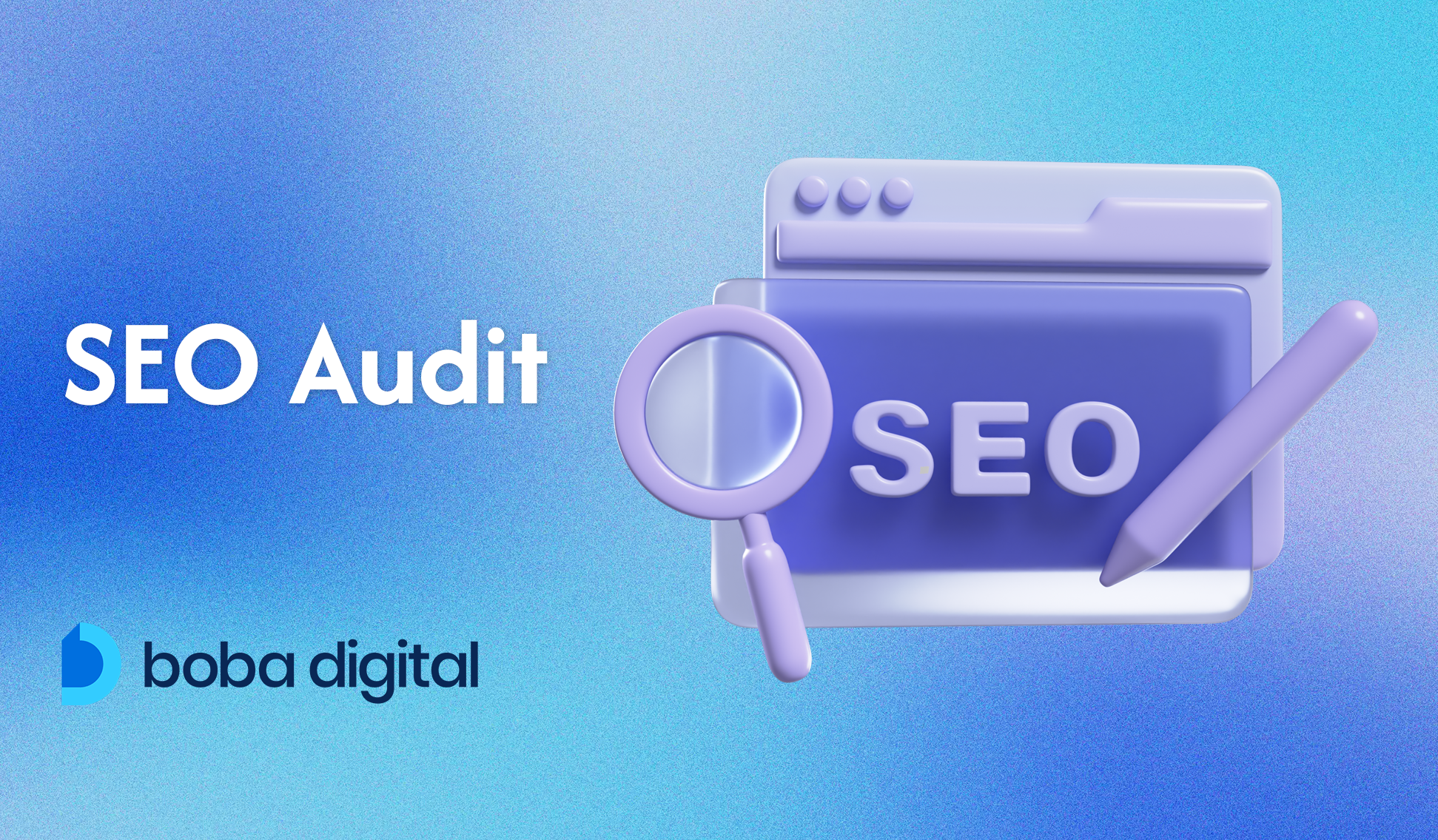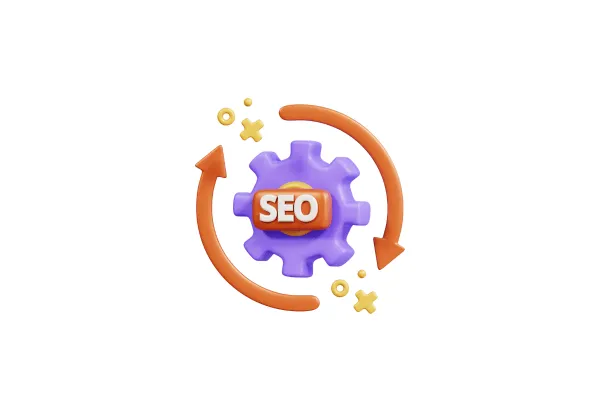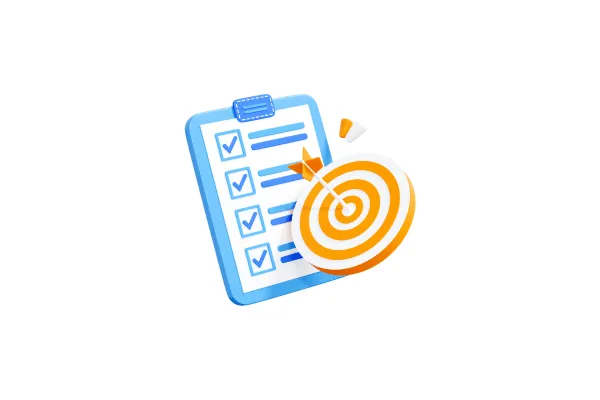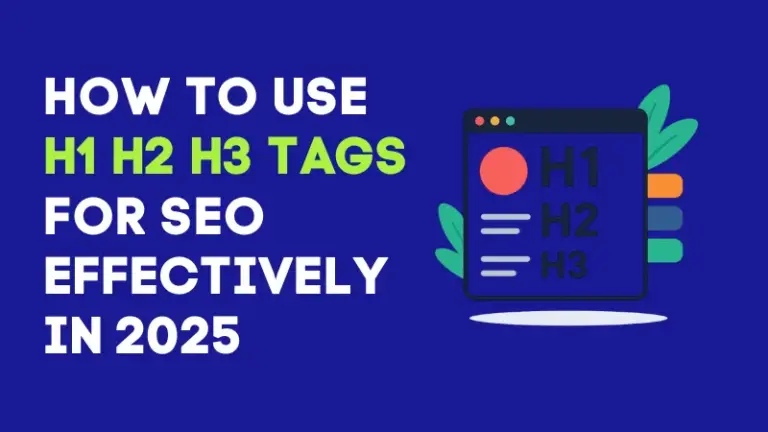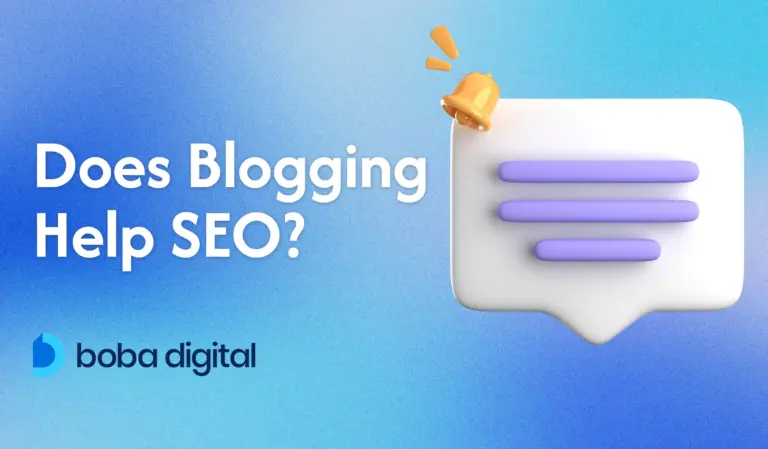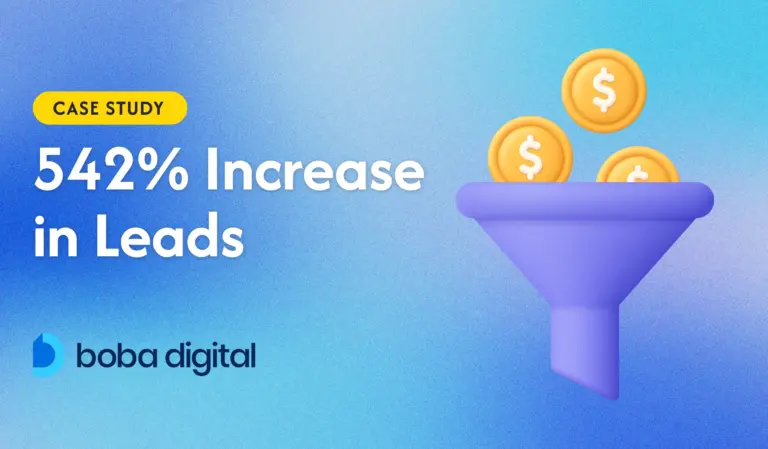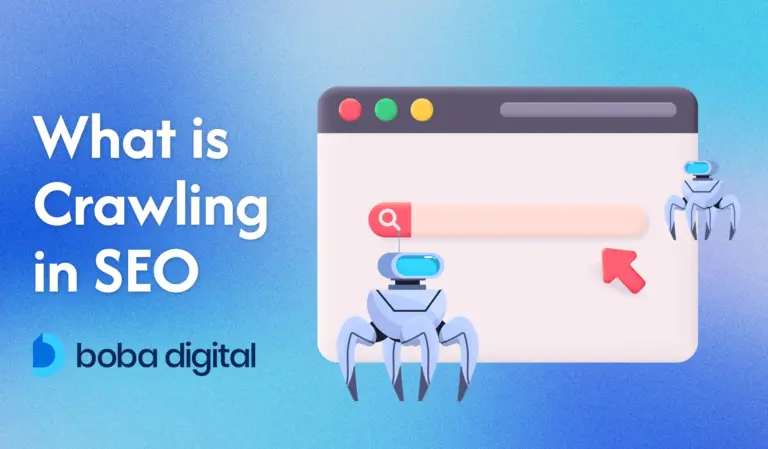SEO Audit: What It Is & Steps to Audit Your Website
Your website is more than just a digital storefront—it’s a key player in driving organic traffic and boosting search engine rankings. But how do you know if it’s performing at its best? That’s where an SEO audit comes in.
A thorough SEO audit helps identify on-page SEO issues, technical SEO elements, and content gaps that may be holding your site back. It’s an essential process for businesses of all sizes—especially small businesses, where every marketing dollar needs to work harder.
By evaluating factors like site speed, keyword usage, and backlink profiles, you can refine your SEO efforts and improve your site’s performance in search results.
In this guide, we’ll break down everything you need to know about SEO audits—why they matter, how to perform a quick SEO audit, and the key steps to optimize your website effectively. Let’s get started!
What is SEO Audit?
Think of an SEO audit like a routine inspection for your website—just as you wouldn’t wait for your car to break down before visiting a mechanic, you shouldn’t wait for your search rankings to drop before assessing your site’s SEO health. Regular SEO audits help identify and resolve issues before they impact your site’s performance, ensuring it operates efficiently and continues driving organic traffic.
An SEO audit is a comprehensive analysis of your website’s search engine friendliness. It examines various factors that influence your visibility on search engines, including on-page SEO, off-page SEO, and technical SEO elements. A well-executed audit covers both the structural framework and the content aspects of your site, ensuring that search engine crawlers can easily navigate, index, and rank your pages.
A thorough audit typically evaluates multiple SEO components, including technical issues, content relevance, backlink profiles, mobile friendliness, and site architecture. By identifying on-page SEO issues, broken links, and opportunities for structured data markup, you can enhance your organic search performance and maintain a competitive edge.
Ultimately, the goal of an SEO audit is simple—to pinpoint weaknesses and uncover opportunities to improve your search engine rankings. Whether it’s refining meta descriptions, enhancing internal links, or resolving crawling and indexing issues, an audit provides the insights needed to fine-tune your strategy and strengthen your site’s SEO over time.
Types of SEO Audits
SEO audits can be categorized into five main types: on-page SEO, off-page SEO, technical SEO, local SEO, and content SEO. Each plays a crucial role in ensuring your website performs optimally in search engine results.
Technical SEO Audit
With over 3.5 billion Google searches happening every day, landing on page one of search engine results pages (SERPs) is critical. Studies show that up to 99% of users never go beyond the first page—meaning if your site isn’t ranking well, it’s missing out on valuable organic traffic. That’s where a technical SEO audit comes in.
A technical SEO audit focuses on the underlying structure and performance of your website. It ensures that search engine crawlers can crawl, index, and understand your content effectively. If search engines struggle to access your site, your rankings will suffer—regardless of how great your content is.
On-Page SEO Audit
On-page SEO refers to everything within your website that affects how well it ranks in search engine results pages (SERPs). It focuses on optimizing individual pages to enhance their visibility, making it easier for search engine crawlers to understand the content and rank it appropriately. A thorough SEO audit examines key on-page elements to ensure they follow best practices.
Key on-page SEO elements include: Title tags, Meta descriptions, Header tags, Keyword integration within content, Image alt texts, URL structures.
Each of these elements provides critical information to search engine crawlers about a page’s content, relevance, and structure. When optimized correctly, these factors improve site ranking, attract organic traffic, and enhance user experience.
Off-Page SEO Audit
Also known as off-site SEO, refers to all activities conducted outside of your website to improve its search engine rankings and increase its visibility. While on-page SEO focuses on optimizing website content and structure, off-page SEO is about building your site’s authority, trustworthiness, and reputation across the web.
One of the most critical components of off-page SEO is backlinks. Backlinks act as endorsements from other websites, signaling to search engines that your content is valuable and worth ranking higher in search engine results pages (SERPs).
However, not all backlinks are created equal. High-quality backlinks from authoritative websites carry more weight than numerous low-quality links. Understanding quality vs. quantity is crucial—relevant backlinks from credible sources drive meaningful referral traffic, while excessive low-quality links can harm your site’s SEO.
Several key metrics help assess a website’s off-page SEO performance, including domain authority, referral traffic, and social signals. Domain authority measures a website’s credibility and influence, often determining its ability to rank well.
A major concern in off-page SEO audits is identifying and removing toxic links. These are unnatural or low-quality backlinks from spammy, irrelevant, or untrustworthy websites. Toxic links can trigger search engine penalties, harming your site’s ranking and credibility. Search engines like Google may perceive them as manipulative, leading to decreased organic traffic and potential manual actions.
Content Audit
A content audit is the process of analyzing and evaluating all content elements on a website to determine their effectiveness in driving organic traffic, engaging users, and improving search engine rankings. By assessing content against specific performance criteria, businesses can identify strengths, weaknesses, and opportunities for improvement.
Chief areas to evaluate during a content audit are Content quality and relevance, Keyword usage, Readability, Search engine ranking, Organic traffic and page views, Session duration, Content gaps, and Competitor analysis.
The ultimate goal of a content audit is to ensure that all content is valuable, unique, and aligned with user search intent. By identifying areas for improvement, businesses can enhance their SEO efforts, improve site ranking, and create a more engaging experience for their audience.
Local SEO Audit
A local SEO audit is a focused evaluation of the factors that influence a website’s visibility in local search results. It assesses how well a business ranks for local search terms, such as “plumbers in Ohio”, and identifies opportunities to improve its site ranking in specific geographic areas. The goal is to enhance local organic search performance, attract more potential customers, and increase calls and conversions.
Key elements of a local SEO audit include: NAP consistency (Name, Address, Phone Number), Google My Business (GMB) listing optimization, Local citations and customer reviews.
Inconsistencies in NAP details across directories can confuse search algorithms, negatively affecting crawling and indexing. More importantly, incorrect business information can damage customer trust—if users find outdated phone numbers, incorrect addresses, or missing details, they may choose a competitor with reliable information. A well-executed local SEO audit ensures that businesses appear trustworthy, relevant, and competitive in local search results.
Why Is an SEO Audit Important?
In the ever-competitive online world, an SEO audit is essential for websites that want to stand out. It helps uncover and fix issues that may be hindering search performance, ensuring your site remains visible, functional, and optimized for organic traffic.
Whether it’s addressing technical SEO issues, improving on-page SEO elements, or refining your backlink profile, regular audits help keep your site in top shape.
One of the biggest benefits of an SEO audit is its ability to identify inefficiencies and highlight areas of risk and opportunities for growth. It provides valuable insights into what’s working and what needs improvement, from crawling and indexing issues to site speed and mobile-friendliness.
Addressing these concerns enhances user experience, making it easier for both search engines and visitors to navigate your site.
Regular SEO audits also help maintain competitiveness in search rankings. Search algorithms are constantly evolving, and what worked yesterday may not be effective today. By continuously monitoring your site’s SEO, you can adapt to changes, fix broken links, update outdated content, and refine keyword usage to improve your search rankings.
When to Perform an SEO Audit?
An SEO audit shouldn’t be treated as a one-time event—instead, it should be an ongoing process to keep your website optimized and competitive. Ideally, a thorough SEO audit should be conducted every three to six months to ensure your site maintains its search engine rankings, continues driving organic traffic, and adapts to evolving search algorithms.
In addition to full-scale audits, mini-audits focusing on specific areas—such as technical SEO issues, keyword usage, or backlink profiles—can be done more frequently, such as quarterly. These smaller audits allow businesses to address SEO issues before they escalate, keeping the site in optimal condition.
There are also certain scenarios that should trigger an immediate SEO audit, including:
- A sudden decline in organic traffic – This could indicate crawling and indexing issues, technical SEO elements affecting visibility, or algorithm updates impacting rankings.
- A higher-than-average bounce rate – Users may be leaving due to slow page speed, broken links, or poor content relevance.
- Lower conversion rates – If visitors are not engaging or converting, an audit can help pinpoint usability issues or gaps in on-page SEO.
- A drop in Google rankings – Whether due to algorithm changes or competition, an SEO audit can help diagnose ranking fluctuations.
What Should You Look for When Conducting an SEO Audit?
A thorough SEO audit examines multiple areas to ensure a website is optimized for search engine rankings and organic traffic. By evaluating technical elements, on-page SEO, off-page SEO, content quality, and local SEO factors, businesses can identify weaknesses and opportunities to improve their search performance.
Here are the key elements you should look for when conducting an SEO audit.
On-Page SEO Audit
This section focuses on the essential on-page SEO elements that impact your website’s search engine rankings and organic search performance.
Title Tags, Meta Descriptions, and Header Tags
Title tags are HTML elements that define a web page’s title. They appear as the clickable headline on search engine results pages (SERPs) and are a key ranking factor, as confirmed by Google’s John Mueller. A well-crafted meta title not only helps with search engine rankings but also encourages users to click on your page instead of a competitor’s.
Best practices for title tags include keeping them between 50-60 characters, ensuring each page has a unique and descriptive title, and avoiding keyword stuffing. The title should accurately reflect the page’s content while being compelling enough to increase click-through rates (CTR).
Meta descriptions, though not a direct ranking factor, play a crucial role in organic traffic. These short summaries appear below the title tag in search results, providing users with a preview of what the page is about. Ideally, meta descriptions should be between 150-160 characters, include relevant keywords, and be engaging enough to drive clicks.
Header tags (H1, H2, H3, etc.) are another critical component of on-page SEO. These tags organize content into a clear hierarchical structure, improving readability for both users and search engines. The H1 tag should be reserved for the main title of the page, while H2 and H3 tags should be used for subheadings to break up content into digestible sections. Properly structured header tags improve SEO rankings by helping search engine crawlers understand the main topics and subtopics of the page.
To optimize these elements effectively, it’s essential to use keywords naturally and avoid duplication. Placing targeted keywords in title tags, meta descriptions, and header tags should feel seamless within the content. Reviewing and refining your content ensures that keywords are strategically placed without being forced or overused.
For a thorough SEO audit, tools like Screaming Frog can help extract and review these elements across multiple pages. This allows businesses to identify missing or duplicate title tags, analyze header structures, and ensure their on-page SEO aligns with best practices.
Keyword Usage and Optimization
Google considers multiple factors when ranking web pages, but content remains the most important element. At the core of any SEO strategy are keywords, which help search engines understand what a page is about and determine its relevance to search queries. However, effective keyword optimization goes beyond just inserting words into content—it requires a strategic, natural approach that enhances both search engine rankings and user experience.
Keyword integration should be carefully analyzed across different areas of a webpage, including titles, headings, meta descriptions, URLs, and body text. When placed strategically, keywords help improve visibility in search engine results pages (SERPs) while maintaining readability for users. However, blindly stuffing content with keywords can harm rather than help SEO.
Keyword Density vs. Natural Language
Keyword density was once a key SEO metric, measuring how often a keyword appeared in content. While keyword presence still matters, modern search algorithms prioritize natural language over repetition.
Natural language SEO ensures keywords blend smoothly into content, enhancing readability and engagement. Overusing them—known as keyword stuffing—can trigger search engine penalties, harming rankings and traffic.
Rather than cramming keywords, focus on natural integration, topic relevance, and user intent. This keeps content valuable, user-friendly, and optimized for search.
Long-Tail Keywords and Semantic Search
Incorporating long-tail keywords is a highly effective way to drive targeted traffic. These keywords are longer, more specific phrases that directly answer user queries, often resulting in higher engagement and better conversion rates. For example, instead of targeting a broad term like “SEO strategies,” a long-tail keyword such as “best SEO strategies for small businesses” caters to a more specific audience.
Semantic search also plays a crucial role in keyword optimization. Search engines now focus on context and intent rather than just exact-match keywords. This means content should use synonyms, related terms, and natural phrasing to improve its relevance without forcing exact-match keywords unnaturally.
Internal Linking Structure
A well-planned internal linking strategy is one of the easiest and most effective ways to boost SEO and improve user navigation. By connecting related pages, internal links help search engines understand site structure and ensure key pages receive the authority they deserve.
At the same time, they guide users to relevant content, increasing engagement and reducing bounce rates.
Anchor text—the clickable hyperlink text—should always be clear and relevant. Instead of generic phrases like “click here” or “learn more,” use descriptive terms that indicate the linked page’s topic. For example, linking to an article on on-page SEO with “best practices for on-page SEO” is far more effective.
A strong internal linking structure also follows a logical hierarchy. Key pages—such as service pages, pillar content, or conversion-focused pages—should be easily accessible and linked from high-authority pages like the homepage or cornerstone blog posts. This approach strengthens SEO while improving user experience.
Identifying and Fixing Broken Links
Broken internal links can disrupt user experience and hurt site performance by leading visitors to dead pages (404 errors). Search engines may also struggle to crawl and index your content properly if internal links are broken.
To identify and fix broken links efficiently, tools like Google Search Console and ContentKing can scan your website and highlight problematic URLs. Fixing or redirecting these links ensures a seamless user journey and helps maintain organic search performance.
Schema Markup and SEO Audits
A schema on-page SEO audit involves analyzing how structured data (schema markup) is implemented across a website to ensure it’s correctly applied and optimized.
Schema markup helps search engines better understand a page’s content, enabling richer search results that can improve search engine rankings and increase click-through rates (CTR). Properly applied schema markup makes your website stand out in search engine results pages (SERPs) by displaying enhanced features like star ratings, event details, or product information.
There are various types of schema markup, each designed to provide additional context about a webpage’s content:
- Review Schema – Displays star ratings and user reviews in Google search results, increasing trust and visibility.
- FAQ Schema – Helps show frequently asked questions and answers directly in SERPs, improving user engagement.
- Local Business Schema – Optimizes local businesses by displaying key details such as address, phone number, and business hours.
- Event Schema – Enhances event listings by showcasing details like event dates, locations, and ticket availability.
- Video Schema – Provides search engines with metadata about embedded videos, helping improve video search rankings.
VALIDATING AND TROUBLESHOOTING SCHEMA MARKUP
To ensure that structured data is correctly implemented, Google offers the Rich Results Test tool. This tool helps validate schema markup, detect errors, and troubleshoot issues. Here’s how to use it:
- Go to the Rich Results Test tool: Rich Results Test Tool
- Enter your URL or paste a code snippet to analyze a specific page.
- Click “Test URL” or “Test Code” to initiate the validation.
- Review the results to check for errors, warnings, and valid structured data implementations.
Off-Page SEO Audit
An off-page SEO audit focuses on external factors that influence your website’s search rankings and organic traffic.
Backlink Profile Analysis (Good vs. Toxic Links)
Evaluating both the quantity and quality of backlinks is essential for maintaining a healthy backlink profile. Simply having a high number of backlinks isn’t enough—quality matters more than quantity. When reviewing your backlink profile, consider the following criteria:
- Source credibility – Are the links coming from high-authority websites, or are they from spammy, low-quality domains?
- Anchor text relevance – Is the anchor text natural, or does it appear overly optimized and manipulative?
- Link diversity – Are backlinks coming from a variety of domains, or is there an unnatural pattern of links from the same sources?
- Contextual relevance – Do the linking websites have content relevant to your niche, or are they unrelated?
- Automated or spammy links – Are there signs of links generated through black-hat SEO tactics, such as link farms or automated tools?
Identifying Toxic or Spammy Links
Toxic links can harm search rankings and may even trigger search engine penalties. Some common red flags of toxic backlinks include:
- Links from low-quality websites with irrelevant content
- Websites with excessive ads or spam-like content
- Suspicious domain names that look unnatural
- Unnatural anchor text patterns (e.g., exact-match keywords used excessively)
- A high volume of links coming from the same low-quality sources
Domain Authority and Referral Traffic
Domain Authority (DA) is a predictive metric that estimates a website’s likelihood of ranking in search engine results pages (SERPs) compared to its competitors. Developed by Moz, this score is calculated using a machine learning algorithm that evaluates multiple factors, such as linking root domains and the total number of backlinks.
A higher DA score generally indicates a stronger ability to rank in Google search results, though it is not a direct ranking factor used by Google.
To measure Domain Authority, SEO professionals rely on tools like Moz’s DA score, Ahrefs’ Domain Rating (DR), and SEMrush’s Authority Score. These tools assess the quality and quantity of backlinks pointing to a domain, helping determine its authority and ranking potential.
While DA and DR provide useful benchmarks, it’s important to compare them against competitors in the same industry rather than focusing solely on increasing the score.
Beyond Domain Authority, analyzing referral traffic sources helps gauge the quality and effectiveness of external links pointing to your site. Referral traffic refers to visitors who arrive at your website by clicking links from other domains rather than through organic search or direct visits.
To assess referral traffic sources, use Google Analytics or similar web analytics platforms to track:
- Which external sites send the most traffic to your pages.
- How engaged the referral audience is, measured by session duration, bounce rate, and conversions.
- The relevance of referring sites—whether they are within your niche or unrelated low-quality sources.
Social Signals and External Mentions
While social signals are not a direct ranking factor in Google’s algorithm, they play an essential role in boosting brand visibility and driving quality traffic to your website.
Social media engagement—including shares, likes, comments, and mentions—helps expand your content’s reach, increasing the likelihood of earning backlinks and organic traffic. When users engage with your content, they contribute to improved site performance metrics, such as longer session durations and lower bounce rates, indirectly benefiting your SEO efforts.
Monitoring external mentions and social engagement allows businesses to understand how their brand is perceived online. Dedicated platforms like Brand24, Sprout Social, and Hootsuite provide insights into:
- How often your brand is mentioned across various social media platforms.
- The sentiment behind these mentions—whether users are engaging positively or highlighting concerns.
- Opportunities to interact with your audience, strengthening relationships and increasing brand authority.
By analyzing social engagement metrics, businesses can identify which content resonates most with their audience and adjust their SEO and content marketing strategies accordingly. Additionally, increased brand visibility from social interactions can lead to more natural backlinks, helping improve search rankings over time.
Content Audit: Ensuring Quality and Relevance
A content audit plays a crucial role in maintaining search visibility and user engagement. Evaluating existing pages helps determine what’s performing well, what needs improvement, and what topics are missing. By refining content, businesses can strengthen their SEO efforts, increase organic traffic, and keep their website valuable to users.
Identifying Content Gaps
Spotting missing topics or underutilized keywords gives businesses an edge over competitors. Instead of guessing which areas need improvement, analyzing competitor content can highlight opportunities to expand coverage. Tools such as SEMrush, Ahrefs, and SurferSEO assist in this process by identifying high-performing keywords and topic clusters that haven’t been fully explored.
To bridge these gaps, businesses should focus on expanding underdeveloped sections, incorporating long-tail keywords, and adding complementary subtopics. Strengthening content in this way ensures users find comprehensive answers without needing to turn elsewhere.
Updating Outdated Content
Over time, older pages lose relevance, leading to drops in organic traffic and engagement. Detecting pages that need a refresh requires Google Analytics, SEMrush, or ContentKing, which highlight high bounce rates, reduced session duration, and declining search rankings.
Once weak content is identified, updating it with current data, improved keyword placement, and enhanced readability ensures it remains useful. Incorporating new statistics, internal links, and additional insights also boosts search engine rankings while reinforcing authority. Establishing a content review schedule—monthly, quarterly, or annually—helps prevent stagnation and keeps information fresh.
Ensuring Uniqueness and Readability
Original content builds credibility and avoids search engine penalties. Ensuring uniqueness involves proper citation, careful paraphrasing, and running content through plagiarism detection tools like Copyscape or Grammarly.
Readability also influences user engagement and SEO performance. Cluttered, complex writing deters visitors, making it essential to structure content for easy consumption. Short paragraphs, clear subheadings, and bullet points improve readability, while tools like Hemingway App refine sentence clarity.
Strong content is both visually appealing and informative. A mix of concise formatting, strategic keyword integration, and regular updates ensures pages remain engaging, relevant, and competitive in search rankings.
Technical SEO Audit: Enhancing Site Performance and Search Visibility
Technical SEO plays a crucial role in ensuring search engines can effectively crawl, index, and understand a website’s content. Without a strong technical foundation, even the most well-optimized pages may struggle to rank. This section explores key technical SEO elements that impact site performance, user experience, and search engine rankings.
Crawlability and Indexing
A site’s content cannot rank if search engine crawlers can’t access it. Errors such as broken links, misconfigured redirects, and blocked pages can prevent indexing, ultimately reducing a website’s visibility in search engine results pages (SERPs).
To diagnose and fix crawl errors and indexing issues, Google Search Console is the best tool:
- Navigate to Google Search Console > Coverage Report to identify indexing errors, such as 404 pages, redirect loops, and blocked URLs.
- The URL Inspection Tool allows manual checks to see if a specific page is indexed or blocked.
Robots.txt File and XML Sitemaps
- The robots.txt file tells search engines which pages they can or cannot crawl. A misconfigured robots.txt can mistakenly block critical pages, preventing them from appearing in search results.
- An XML sitemap provides search engines with a structured roadmap of a website’s important pages, making it easier for crawlers to discover and index them.
Common Issues and Fixes:
- Mistakenly blocking important pages: Check the robots.txt file for directives like Disallow: / that may unintentionally prevent pages from being crawled.
- Sitemap including non-canonical URLs: Ensure that only canonical URLs are listed in the XML sitemap to avoid duplicate content confusion.
- Orphan pages (pages without internal links): Identify and link important pages internally to improve their discoverability.
Site Speed and Core Web Vitals
Page speed is a major ranking factor, and Google uses Core Web Vitals to measure a website’s performance and user experience. The three key metrics are:
- Largest Contentful Paint (LCP) – Measures loading speed; should be under 2.5 seconds.
- First Input Delay (FID) – Tracks interactivity; should be less than 100 milliseconds.
- Cumulative Layout Shift (CLS) – Measures visual stability; a CLS score below 0.1 is ideal.
To evaluate page speed, use Google PageSpeed Insights or GTmetrix:
- Run the page speed test three times to account for variations.
- Analyze the results and take the average score.
- Implement necessary optimizations, such as:
- Enabling compression (Gzip, Brotli)
- Reducing image sizes with WebP format
- Minimizing JavaScript and CSS blocking elements
- Leveraging browser caching
A well-optimized site ensures faster load times, better user engagement, and improved search rankings.
Mobile-Friendliness
With Google’s mobile-first indexing, a seamless mobile experience is essential. A poorly designed site can increase bounce rates and reduce conversions. Use Google’s Mobile-Friendly Test to assess responsiveness and usability.
Common Mobile Issues and Fixes
- Viewport misconfiguration: Ensure the <meta name=”viewport” content=”width=device-width, initial-scale=1″> tag is correctly implemented.
- Touch elements too close together: Buttons and links should be easily tappable, maintaining proper spacing.
- Inconsistent experience across devices: The site should offer a seamless design whether accessed on mobile, tablet, or desktop.
A responsive, user-friendly design not only improves SEO rankings but also boosts conversion rates by making navigation easier for users.
HTTPS/SSL Implementation
Website security is a key ranking factor and an essential trust signal for users. HTTPS encryption ensures secure connections, protecting user data and reducing the risk of security warnings that deter visitors.
To verify HTTPS implementation:
- Check for a padlock icon in the browser’s address bar, confirming SSL encryption.
- Ensure all pages load over HTTPS by typing https://yourwebsite.com in the browser.
- Identify mixed content issues, where some resources (e.g., images, scripts) still load over HTTP, causing security warnings.
SSL certificates can be obtained for free through Let’s Encrypt or purchased from hosting providers, typically costing up to a few hundred dollars annually.
A properly configured SSL certificate enhances site security, user trust, and search rankings, making it a necessity for modern websites.
XML Sitemap
A well-structured XML sitemap helps search engines efficiently discover and index important pages. The sitemap should only contain canonical URLs, ensuring that duplicate or unnecessary pages do not dilute indexing signals.
Using Google Search Console:
- Submit and validate your XML sitemap under Sitemaps in Search Console.
- Check for errors or excluded pages that may indicate crawl issues.
Local SEO Audit: Strengthening Local Search Visibility
A local SEO audit ensures that businesses maintain a strong presence in local search results, making it easier for potential customers to find, trust, and engage with them. Key aspects of a local SEO audit include maintaining NAP consistency, optimizing Google My Business (GMB), and managing local citations and reviews.
NAP Consistency (Name, Address, Phone Number)
Maintaining consistent NAP information across all platforms signals to search engines like Google that a business is legitimate and trustworthy. When Name, Address, or Phone Number details vary from one listing to another, search engines may struggle to verify the business’s authenticity, leading to a drop in local rankings.
Common Issues with NAP Inconsistency:
- Variations in spelling or abbreviations across different platforms.
- Old addresses or phone numbers that no longer reflect the current business location.
- Mismatched details on Google My Business, Yelp, Bing Places, and other directories.
How to Verify and Maintain NAP Accuracy:
- Manually check listings on major directories like Google Business Profile, Yelp, and Bing Places.
- Use local SEO tools like BrightLocal or Moz Local to audit, update, and maintain consistency across all platforms.
- Create a monthly or quarterly schedule to verify and update business information, ensuring consistency across all digital platforms.
Ensuring uniform NAP details across every listing strengthens local search rankings, boosts business credibility, and prevents confusion among both search engines and potential customers.
Google My Business Optimization
A well-optimized Google My Business (GMB) profile is one of the most powerful tools for improving local search visibility. Businesses that actively manage their GMB profiles tend to rank higher in Google’s Local Pack and Google Maps searches.
How to Audit a GMB Profile:
- Choose the best category and sub-category to ensure Google correctly classifies your business.
- Check the frequency of Google Posts updates—regular updates help keep the profile active.
- Review Google Business Profile Insights to assess search visibility and engagement metrics.
- Verify contact information, address, and business hours to ensure accuracy.
- Confirm that the public email address is monitored, allowing potential customers to reach out easily.
- Use the Q&A feature to answer customer inquiries directly.
- Upload high-quality images and videos showcasing products, services, or the business location.
- Respond to all customer reviews, addressing both positive and negative feedback professionally.
A fully optimized Google My Business profile increases the chances of appearing in local search results, helping businesses attract more foot traffic and online inquiries.
Local Citations and Reviews
Local citations are online mentions of a business’s NAP information across various directories, websites, and social platforms. Having consistent citations on sites like Yelp, Bing Places, and industry-specific directories strengthens a business’s authority and improves local search rankings.
Ensuring Accurate Business Listings:
- Audit major citation sources using tools like Moz Local or BrightLocal to identify incorrect or missing listings.
- Update or claim business profiles on high-authority directories.
- Monitor new citations to prevent outdated or duplicate listings.
Essential Tools for a Comprehensive SEO Audit
A successful SEO audit requires a combination of tools to assess technical performance, backlink health, content optimization, and page speed. Using the right tools ensures a data-driven approach, allowing businesses to identify critical issues and opportunities for improvement.
Crawling and Site Structure Analysis
Crawling tools simulate how search engine crawlers navigate a website, identifying technical SEO issues that may impact indexing and rankings.
- Screaming Frog: This tool scans every page of a website, extracting data such as URLs, page titles, meta descriptions, header tags, duplicate content, and broken links. It provides insights into on-page SEO issues and helps optimize site structure.
- Sitebulb: Similar to Screaming Frog, Sitebulb delivers detailed crawl reports but also visualizes site architecture, making it easier to spot structural problems such as orphan pages and inefficient internal linking.
These tools highlight broken links, missing metadata, and duplicate content, helping businesses maintain a well-structured and crawlable website.
Technical SEO Analysis
Technical SEO tools uncover crawling errors, indexing issues, and performance bottlenecks that impact search engine rankings.
- Google Search Console: A free and essential tool for monitoring a website’s search presence. It helps identify crawl errors, mobile usability issues, indexing problems, and performance metrics.
- DeepCrawl: Offers a more in-depth analysis, uncovering issues such as server errors, JavaScript rendering problems, and improper canonicalization.
Backlink Tracking and Off-Page SEO
Analyzing a website’s backlink profile is crucial for off-page SEO, as links from authoritative domains boost search rankings and credibility.
- Ahrefs: Provides an in-depth backlink analysis, showing referring domains, link quality, anchor text distribution, and lost or broken links.
- Moz Link Explorer: Helps assess Domain Authority (DA), identify toxic links, and track backlink growth over time.
A well-maintained backlink profile is essential for improving off-page SEO, and these tools help uncover valuable linking opportunities while flagging potential spammy links that could harm rankings.
Content Optimization and Search Intent Matching
Content must align with search intent to rank effectively. Tools that leverage natural language processing (NLP) help refine content for maximum relevance and keyword optimization.
- SurferSEO: Analyzes top-ranking pages and provides recommendations on keyword usage, content length, and related entities to improve ranking potential.
- NeuronWriter: Uses AI-driven content analysis to suggest optimizations based on semantic relevance and search trends.
- ClearScope: Helps refine content structure by offering contextual keyword suggestions to improve on-page SEO.
Post-Audit Action Plan: Turning SEO Insights into Results
Conducting an SEO audit is only the first step—what truly matters is how the findings are implemented. A structured action plan ensures that issues are addressed efficiently, keeping the site optimized for search engines and users alike.
By prioritizing tasks, collaborating with teams, and setting up ongoing monitoring, businesses can maintain search visibility, improve performance, and stay ahead of SEO trends.
Creating a Prioritized Roadmap
Not all SEO issues require immediate action—some have a greater impact on rankings and traffic than others. Creating a prioritized roadmap helps businesses focus on what matters most while allocating resources efficiently.
- Immediate Fixes (High Impact, Low Effort)
◦ Fix broken links and ensure all pages lead to relevant destinations.
◦ Update missing or duplicate meta tags for better on-page SEO.
◦ Resolve crawl errors in Google Search Console to improve indexability. - Mid-Term Adjustments (Moderate Impact, Medium Effort)
◦ Optimize content for search intent, refining keyword placement and readability.
◦ Enhance internal linking structures to improve page discoverability.
◦ Ensure NAP consistency across all local listings for better local SEO performance. - Long-Term Projects (High Effort, Gradual Impact)
◦ Overhaul site speed by improving Core Web Vitals and server performance.
◦ Strengthen backlink strategy to increase domain authority.
◦ Implement structured data markup for enhanced search engine visibility.
To maintain SEO health, audits should be scheduled every 6 to 12 months, ensuring that the site remains competitive and compliant with evolving search algorithms.
Final Words
Proactively addressing SEO challenges allows businesses to enhance user experience, drive organic traffic, and maintain long-term ranking stability. Whether you’re launching a new strategy or fine-tuning an existing one, the foundation of sustainable growth begins with a comprehensive SEO audit.
At Boba Digital, we provide end-to-end SEO services, starting with a detailed audit and competitor gap analysis. This process helps uncover hidden opportunities, pinpoint areas for improvement, and develop data-driven strategies that drive lasting success.
Ready to im your website’s performance? Contact Boba Digital today to kickstart your SEO audit and unlock your site’s full potential!
FAQs
How often should I perform an SEO audit?
SEO audits should be conducted every 6 to 12 months to keep up with search engine updates, fix technical issues, and maintain rankings. However, if you notice sudden traffic drops, broken pages, or indexing issues, an immediate audit is recommended.
What tools are necessary for an effective SEO audit?
Essential tools include Google Search Console for crawl and indexing issues, Screaming Frog for site structure analysis, Ahrefs or Moz for backlink tracking, SurferSEO for content optimization, and Google PageSpeed Insights for performance checks.
Why is backlink analysis important in an audit?
Backlink analysis helps identify toxic links, lost backlinks, and referral traffic sources. Strong backlinks improve domain authority and rankings, while spammy links can trigger penalties. Using tools like Ahrefs or Moz Link Explorer ensures a healthy backlink profile.
What should I do after completing an SEO audit?
Prioritize quick fixes like broken links and missing meta tags while planning long-term improvements like site speed optimization and content updates. Collaborate with developers, content teams, and SEO experts to implement changes effectively.
Can I perform an SEO audit without technical expertise?
Yes! While technical SEO knowledge helps, many tools like Google Search Console, Screaming Frog, and SurferSEO provide user-friendly insights. However, for complex fixes, partnering with an SEO agency can be beneficial.
Are SEO audits necessary if my traffic isn’t dropping?
Absolutely! SEO audits help maintain search visibility, uncover missed opportunities, and prevent future issues. Even if traffic is stable, regular audits ensure your site remains optimized for search engines and users.

